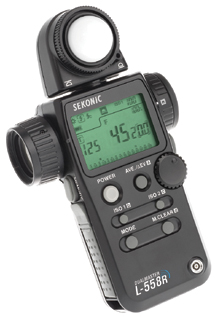Sekonic’s DualMaster L-558R Flash/Ambi Meter; Exposure Measurement Doesn’t Get Any Better Than This
Handheld exposure meters have grown increasingly complex over the years. At the same time, they are proving even more utilitarian for a wider range of shooting situations. All of this thanks to microprocessor control. I won't go into the long history of their evolution, but suffice to say that today's high-tech marvels are something else entirely. And the new Sekonic handheld meters establish new benchmarks each step of the way. The coolest and most sophisticated of these is the DualMaster L-558R. While sold separately, it has also been fortified with fancier packaging as the Sekonic X-Rite Digital Suite (see sidebar below), designed to facilitate the digital workflow process. Digital Suite comes with the MonacoOPTIXXR colorimeter to calibrate and profile CRT and LCD monitors on PCs and Macs.
 |
The DualMaster L-558R: An Overview
By itself, the L-558R is a powerful tool for ambient light and flash exposure
control, by either incident or reflected light. The L-558R (note the "R") adds a built-in Digital Radio Transmitter
Module that is compatible with all PocketWizard Digital Radio Wireless Receivers
(www.pocketwizard.com for more info). More and more photo gear, especially strobes,
comes equipped with this wireless slave-triggering technology these days. And
you can always buy the receiving unit separately for camera or flash. Since
the radio receiver is not part of the package and none of my gear comes with
it built-in, this feature was not tested. But in practice, the radio-triggering
system allows you to trigger the lights with the meter, as you would in flash
Cord mode, while doing away with any troublesome sync cord connections. Commercial
photographers I've worked with have raved about the PocketWizard ever
since its introduction, so we know it works. But how well does the meter itself
work? That's what we're here to find out.
Standing on its own, the L-558R is a very sophisticated photo tool. The meter
is large by comparison to others boasting similar capabilities, but with good
reason: It incorporates a 1Þ spot meter with parallax-free optics. The
spot meter replaces the typical broad-area reflectance reading capability found
on many handheld meters.
Spot measurements begin with a twist of a dial around the eyepiece (which has
diopter correction), switching over from Incident to Reflectance mode. When
the meter is first turned on, or when the mode setting is changed, an icon on
the display blinks for a short period to make you aware of which setting is
in effect--nice touch. (Note: There is no lens cap for the eyepiece, so,
when not in use, it might be best to keep the meter inside its padded pouch,
which will also protect the display.)
On the flip side, when the dial is set to Incident mode, the rotating turret
with its white plastic dome comes into play. The dome is recessed for travel
and for taking contrast readings. A short twist raises the dome in preparation
for incident-light exposure measurement.
As with many cameras, you first have to input the film speed in a handheld light
meter. The L-558R has two ISO settings, for instant readings with different
films. The meter is powered by a long-lasting CR123A lithium battery. The meter
will power down on its own, but it never hurts to save battery power and turn
the meter off when not needed.
 |
|
 |
|
 |
|
|
An Extremely Versatile Light Meter
Because many of us have grown to rely on a camera's built-in TTL metering
system, we may feel we no longer need a handheld meter. But that couldn't
be further from the truth. For starters, it takes an extremely long, bulky lens
to deliver true 1Þ spot readings.
Beyond that, this meter can do what your camera meter cannot. While some cameras
may be able to read and average several readings, that's as far as they
go. With this meter, you can store up to nine readings in memory--flash
or ambient light--and recall those readings after shutdown. Usually you
could suffice with a spot reading of a key highlight and key shadow value to
determine brightness range. The touch of a button averages those readings for
the recommended exposure settings in f/stops and shutter speeds.
With Incident mode, you may want to determine lighting contrast--the contribution
of the key light and fill light measured separately, with the recessed dome
aimed in the direction of each light source--before making a final exposure
reading with the dome raised and all studio lights switched on.
Alternatively, take a singular key reading, then put the meter in AVE/EV-A mode
for contrast measurement, and hold down the measuring button again while aiming
the recessed dome or the spot lens as needed. The L-558R will deliver a direct
reading of the difference in EVs, to help establish contrast. (Refer to a table
in the manual to translate that value to contrast ratios.)
- Log in or register to post comments

































